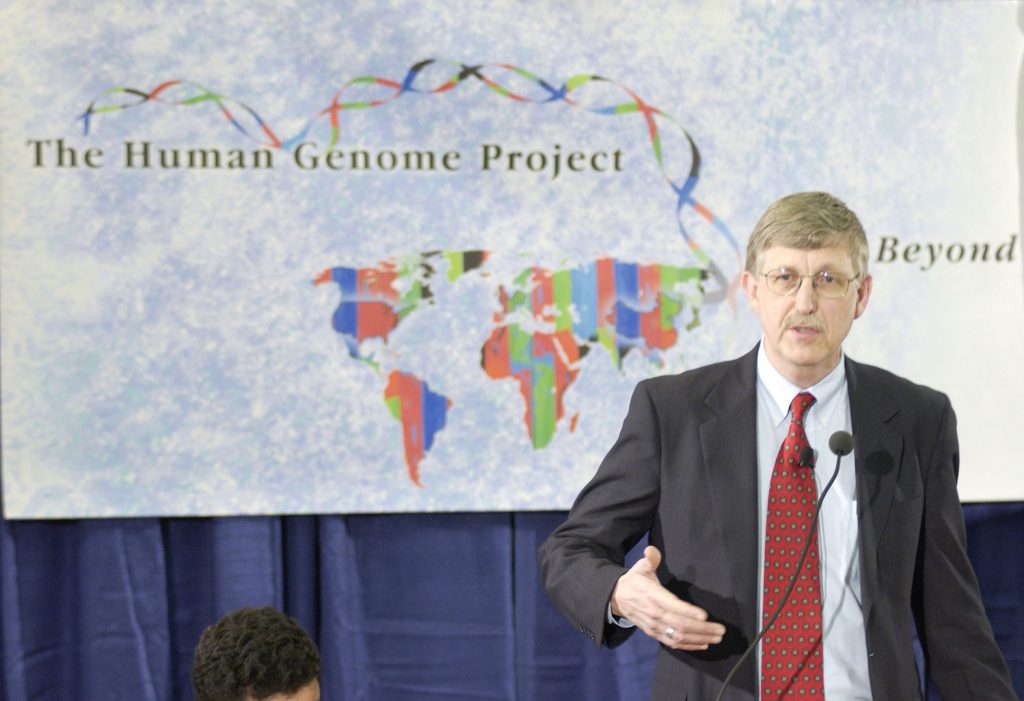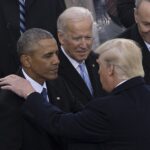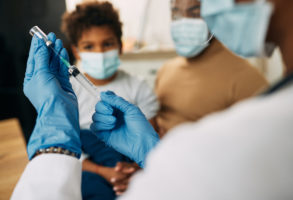
Published March 17, 2020
“There are estimates that if nothing goes right and if we fail to flatten the curve and if health systems are overwhelmed, we might see the deaths of as many as a million and a half people in the United States.”
That’s what Francis Collins, the director of the National Institutes of Health, told me on Saturday. Collins is one of the most widely respected physician-geneticists in the world, who is deeply involved in containing the coronavirus pandemic. (Anthony Fauci, arguably the leading infectious-disease specialist in the world, works for Collins at NIH and is a close friend.)
Collins was not offering a prediction, but a realistic worst-case scenario of what awaits America in the next eight weeks or so unless, in his words, we embrace “the more extreme version” of social distancing.
“If you look at the rates of new cases that are being diagnosed, we’re on an exponential curve,” Collins told me. “That curve, some would say, places us only about eight days behind Italy. If that’s true, we have only a very short period of time before this becomes an obvious national crisis with many people presenting with serious illness and hospitals quickly becoming very stressed with the ability to handle all of these sick people, especially older people who are at higher risk and who may need not just a hospital bed but even a ventilator.”
I asked Collins if that means that we seem to be tracking with what happened in Italy.
“Right,” Collins told me. “If you look at the curve of new cases being diagnosed over the course of the last month, just look at the curve of what happened in Italy, and then look at our curve in the U.S., and you say if you go back eight days from today, they had about the same number of cases that we have today—that is, slightly over 2,000. And then if we follow that same track, then eight days from [March 22], we would be having the same kind of incredible crisis that they are facing.” (The New York Times, in describing the catastrophe befalling Italy, wrote, “The coronavirus epidemic raging through Italy has already left streets empty and shops shuttered as 60 million Italians are essentially under house arrest. There are the exhausted doctors and nurses toiling day and night to keep people alive. There are children hanging drawings of rainbows from their windows and families singing from their balconies. But the ultimate metric of pandemics and plagues is the bodies they leave behind. In Italy, with the oldest population in Europe, the toll has been heavy, with more than 2,100 deaths, the most outside of China. On Monday alone, more than 300 people died.”)
Collins added this important qualifier: “Now we have a chance to change that, by applying now the most draconian measures on social distancing to try to limit the spread of coronavirus from person to person. But we will not succeed at changing the course from that exponential curve unless there is full national engagement in those commitments to try to reduce spread. I think we’re getting there; certainly in the last few days there seems to be a lot of waking up to just how serious the threat is, but that’s obviously not universal across this large and complicated country.”
Since our interview, we’re seeing what “waking up” means in concrete terms: Ohio is postponing its presidential primary and ordering restaurants and bars to close as of 9 p.m.; Washington State and Maryland announced the shutdown of restaurants and bars (except for delivery and takeout), and entertainment venues and recreational facilities. The new mandates from Washington’s Governor Jay Inslee will also require reduced occupancy for retail outlets. California called for all people 65 and older to shelter in their homes. In Los Angeles, Mayor Eric Garcetti closed movie theaters and gyms, while the Bay Area is in lockdown, requiring people to stay home except for essential needs. More than 30 states have closed down schools. The Centers for Disease Control and Prevention recommended Sunday that no gatherings with 50 people or more—including weddings, festivals, parades, concerts, sporting events or conferences—be held in the United States for the next eight weeks. On Monday, it went a step further, saying we should avoid gatherings of more than 10.
When I asked Collins what has surprised him most about the coronavirus from his perspective as a doctor and a scientist, he told me: “The degree to which this is so rapidly transmissible. More so than SARS was. SARS was a terribly scary situation for the world 18 years ago, but it never reached the level of infections or deaths that we have for this coronavirus because it wasn’t as transmissible. SARS was transmissible but only from people who were really very sick. This one seems to be transmissible from people who have minor illness or maybe no illness at all—which is why it has been so difficult to get control or to know when you should be imposing these stringent measures we’ve been talking about. If you wait until you’ve seen lots of affected cases, you know you’ve waited too late because the number of people who haven’t yet turned up in the health-care system but who are already infected is probably 100 times the number of cases you know about.”
What’s being done to help hospitals that are being overwhelmed, I asked Collins, and what about the issue of ventilators and protective gear?
“There’s a huge effort to try to prepare for that in terms of inventories of personal protective equipment, the so-called PPE, there is a national stockpile and we’re trying to figure out how best to distribute that where it will be most needed,” he told me.
“Every hospital is looking at what their capabilities might be and what they might have to do in terms of setting up additional facilities nearby. With universities having closed up for students, it’s possible we may need to see university space used as spill-over for patient care. There are lots of concerns about whether there are enough health-care professionals, especially in places that were already short on physicians like in rural communities. There is a major effort organized through [Health and Human Services], but obviously a lot of it is going to come down to what happens at the community level. And a lot of it will depend upon whether we’re successful in flattening that curve so that the needs for intense medical attention stretches out over the course of several months as opposed to hitting us all at once in the next few weeks.”
Because we don’t yet have a vaccine and we don’t yet have therapeutics that we know work, the best means of trying to prevent what Collins says “could be a really terrible outcome,” in addition to social distancing, is using sanitizers and washing your hands faithfully with hot water and soap for 20 seconds as often times during the day as you possibly can. “Those all seem like medieval practices, but they work,” he told me.
The soonest a vaccine will be available is a year to 18 months, despite “being developed in record time,” according to Collins, so that’s off the table for now. (One vaccine began phase 1 trials in 45 volunteers on Monday.) More encouragingly, he said, “I would hope that the therapeutic aspects—most notably with a drug called remdesivir, which is now in clinical trials in China, Japan, South Korea, and the U.S.—will show that that particular anti-viral has considerable efficacy for people who are very sick. That would help a lot if we actually had a drug that could be offered to people who most need it.”
He added, “It’s a drug that actually was developed in part by academic researchers supported by NIH and then taken on by Gilead, and which did show strong effectiveness against MERS, a related coronavirus, in an animal model. But one hopes that this drug might turn out to be beneficial in this current pandemic. If we had that as a potential medical intervention for the people who most need it, that could change things very much for the better because all the modeling assumes that there’s nothing that we have to offer except supportive care.” The earliest trials should give a result sometime this spring, according to Collins.
I asked Collins when he imagines the testing regime will be at a point where he’ll be happy and it will be giving Americans the information he feels is needed.
“I would hope in the next two weeks we’ll get there. It may start in those zip codes where the incidence of the disease appears to be the highest, and then quickly spread across the country. This model of having drive-through testing facilities in parking lots seems like the best way to make this accessible to people who really should be getting tested. But that’s pretty complicated to set up. It’s going to take an awful lot of moving parts to come together.”
Collins conceded, as has Fauci, that the well-publicized testing failures of the CDC were a blow. “It’s truly unfortunate that the testing got off to such a bad start. The CDC did have in place a plan, and this is certainly what they’ve done before, like with H1N1, where they have the capabilities of putting together a test fairly quickly and then distributing it to the state health departments. Keep in mind the CDC is a federal organization, but most of what they try to get done has to be done through state health departments, which are often underfunded and unprepared for an event like what we are seeing now.”
Collins, honest and a man of integrity, added, “Unfortunately, their very rapid development of this test ended up delivering kits that were defective for reasons that I don’t entirely understand. That meant we lost a period of maybe three weeks while they were trying to figure out how to fix the problem. Meanwhile, the FDA, which normally is pretty stringent about who’s allowed to offer tests of this sort that are going to have a profound impact on clinical decision-making, did decide to relax that stringency in order to unleash the ability of other laboratories who had made their own tests to begin to use them. But that came at the very last day of February after a lot of time had passed where testing ideally should have been widely available. There was a plan back in February to begin to sample in five cities anybody who showed up in an emergency room with a flu-like illness who tested negative for influenza—so that we could begin to find out what is the representation of coronavirus in the community. But that plan didn’t happen because the testing wasn’t working. We are now playing catch-up.”
When I asked Collins what that specifically means, he said, “this is moving in the direction of having drive-through facilities at Walgreens, Walmart, and Target where you could drive up after getting an online approval. That means you would have a specific need for the test, which means you’ve got to have symptoms of some sort. You could then get the test done without ever getting out of your car, so it doesn’t expose other people.” The hope is that this would greatly open up the potential for testing, which has happened for example in South Korea, where they’ve given tens of thousands of tests in this fashion.
“There are such drive-by facilities already popping up in New Rochelle, New York, and at a few other places around the country. And this does seem like the right kind of model. I wish we’d had those functioning a month ago. We’d be in a much better place to know what’s coming. But here it is, we can’t go back and reinvent that, and we are pulling out all the stops to make it happen as fast as possible.” (That’s much more in CDC’s sweet spot than it is NIH, but NIH is doing what it can to help.)
I asked the NIH director what the best-case scenario might look like. “The best hope would be that the measures now being implemented in most states, some quicker than others, will slow the transmission of the virus so that it extends over many months instead of over the next three weeks,” he said. “That’s what we mean by ‘flattening the curve’ to give the health-care system a chance to take care of those who are seriously ill. That way we won’t have an example like Italy in our own country. On top of that, I would hope that the chance that this virus will begin to fade during the arrival of warmer weather will turn out to be true. That certainly has helped with influenza. We have no reason to think that that will necessarily apply to coronavirus, but it might. So let’s hope for that.” He added that he hopes therapeutic options, such as remdesivir, will turn out to help people who are sick.
Collins also spoke about civic responsibility and the importance of selflessness in the midst of a pandemic. “I think we as a nation have to get into a place of not just thinking about ourselves, but thinking about everybody else around us, and particularly the most vulnerable people—those who are older and those people with chronic diseases. Young people may have a relatively low risk of serious illness, kids seem to have a very low risk, but if you want to avoid what could be the deaths of hundreds of thousands of people, then it is incumbent on all of us to severely limit our social interactions. We need to ask the question about every interaction we have, and whether it is necessary or not. I’m going to speak very strongly about that. Obviously, people do have to get food in the house and do other absolutely essential things, but beyond that, we should be volunteering to engage in the most stringent kind of isolation.”
He added, “that means we all need to take responsibility even if we are thinking of ourselves as relatively impervious to this illness. It would be easy for a young person to look at the data and go, ‘Well, you know, what if I get it? I’m probably going to be fine.’ But you have to think of yourself also as a vessel for other vulnerable people. Even if you don’t think you need to do this kind of isolation for your own good, you’re doing it for the rest of the country—and particularly for your grandparents and other people who are in a vulnerable state.”
And Collins also offered a big picture-perspective for Americans. “I think people need to be prepared that we are going to be in this space for more time than they will like,” he said. “In many ways, the best sign that we’re making progress will be that the duration of the epidemic goes on a little longer. That’s what flattening the curve means. It means that the most serious cases do get stretched out over time and don’t all happen right at the beginning. So anybody’s who’s imagining that this will all be over and done within a month, needs to get their mind around the fact that we’re in this, I think, for quite a long stretch of time. I can’t imagine that schools that have decided to give students off two weeks will be back in session then, and probably not for this whole academic year. I think we’re facing the fact that at least until June, we all need to be in the space of taking this with the greatest seriousness—and that means every American taking responsibility about this and not coming up with reasons why it’s not necessary.”
The coronavirus crisis is merely the latest chapter in the dazzling career of Francis Sellers Collins.
Collins, who grew up on a farm in rural Virginia—he was homeschooled until the 6th grade—received a B.S. in chemistry from the University of Virginia, a Ph.D. in physical chemistry from Yale University, and an M.D. with honors from the University of North Carolina at Chapel Hill. (He completed his Ph.D. his first year in medical school.)
Collins once told me in a private conversation what those who know him best can testify to: helping people who are suffering has always been a commitment. That was part of what explained his shift in focus from physical chemistry to medicine. “Although I loved the experience of working in quantum mechanics and wrestling with second order differential equations, it was lonely” he said. “It did not have that kind of human connection that I was beginning to long for. And that did drive me then to seek another way to explore science that was going to be more sociable, but also more devoted to outcomes that would help people who were suffering—and medicine was the perfect path to go down, even though it seemed like quite a dramatic departure from the career trajectory I had been on.”
Collins eventually found his way to the University of Michigan, where he spent nine years on the faculty and focused on internal medicine and genetics and met his future wife, Diane Baker. At Michigan, Collins was part of a team that among other things identified the major gene defect that causes cystic fibrosis, one of the most common genetic killers in the United States.
In 1993, Collins joined NIH, the world’s leading organization supporting biomedical research, and led the Human Genome Project. He made landmark discoveries in the genetic origins of various disorders and was the leader of an effort that revolutionized the practice of medicine: the announcement on June 26, 2000, that scientists had completed the first survey of the entire human genome, the set of instructions that defines the human organism. It revolutionized the diagnosis, prevention and treatment of most human diseases. The New York Times described it as “an achievement that represents a pinnacle of human self-knowledge,” and it ranks among the most significant breakthroughs in medical science in history. (Collins was awarded the Presidential Medal of Freedom in November 2007.)
Reflecting back on the events of 20 years ago, Collins told me, “I thought long and hard about what I was going to say that morning, and wrote [my speech] at five that morning. It was particularly poignant because my sister-in-law had died of breast cancer a few days earlier and I had spoken at her funeral on that Saturday and this was the Monday morning where I was talking about how the human genome sequence was going to help a lot of things, including cancer—but it hadn’t come quickly enough for her. So I had that very much on my mind.”
But his earlier work on cystic fibrosis had already taught him that translating basic research into treatment can be complicated. “At the time,” he told me, “this was a moment of celebration because we finally had an answer and we could finally do accurate diagnosis, and I hoped that that might lead fairly quickly to better treatments for all these young adults and kids suffering from this disease. It was a long, hard journey to get the therapeutic side of this to start to work.”
The big moment came 30 years later, in November of last year, when the announcement was made based on rigorous clinical trials that a triple drug therapy would provide, if not a cure, certainly a remarkable improvement in the life experience of 90 percent of people with cystic fibrosis who might now be able to live out a pretty normal life span.
“I did have the chance to be there in Nashville on that day as this announcement was being made,” Collins said. “This is a community I had stayed close with for all of those 30 years, even when my lab was no longer working on cystic fibrosis. I had written a song about what we all hoped might happen someday, way back in the 1990s, a song called “Dare to Dream.” Now that dream was coming true. At that moment, with 5,000 people gathered as scientists, care providers, families, people who had cystic fibrosis all gathered in that same room, we all sang that song together.”
“Boy, it was hard to get through it without really breaking down because all of the people represented in the room, and what they had gone through, their courage, their determination, their belief that this could happen, represented there in the most dramatic way. It felt like such a moment of thankfulness that God’s grace had somehow gotten us to this point. I will not forget that.”
I first met Francis Collins when I worked in the White House during the George W. Bush presidency. He, Michael Gerson, the president’s chief speechwriter, and I had lunch in the West Wing to discuss not politics but science and faith. (All three of us were concerned about some prominent Christians who were denying evolution, which we knew was anti-science and we believed was discrediting to the Christian witness.) Most of those who know about Collins associate him with science; far fewer know about his interest in Christian witness. So I asked him to describe his journey of faith.
Growing up, Collins’s religious instruction was limited to being sent to the local Episcopal church choir to learn music, “instructed by my dad to ignore the rest of it, which I did,” he told me. In college and then graduate school, he found himself moving from the category of agnostic to atheist. “I would have challenged anybody who wanted to bring to the conversation some discussion about God. I would have asserted they were basically stuck in some past era of supernaturalism that is no longer necessary because science has eliminated the need for it,” is how he put it to me. But the time came as a third-year medical student when he was no longer learning about the human body in a lecture hall; he was sitting at the bedside of people who have terrible illnesses, most of which physicians had imperfect methods to be able to help.
“Watching those individuals’ fates, what was going to be coming soon, the end of their life, I was trying to imagine what I would do in that circumstance,” Collins shared with me. “This was in North Carolina and there were a lot of wonderful individuals, many of them having had relatively simple lives, but lives that were totally dedicated to helping other people. Many of these people were deeply committed to faith. I was puzzled and unsettled to see how they approached something that I personally was pretty terrified about, the end of their lives. They had peace and equanimity, and even a sort of sense of joyfulness that there was something beyond. I didn’t know what to do with it.”
“It made me realize that I had never really gone beyond the most superficial consideration of whether God exists, or a serious consideration about what happens after you die.”
Collins told me about a patient he had gotten pretty attached to—“she reminded me of my grandmother,” he said—and who suffered from advanced cardiac disease, which included episodes of almost daily crushing chest pain. “And yet she came through this all with remarkable peace and was very comfortable sharing the reasons for that with me, namely her faith in Jesus. And at one point after one of those sharing moments, she looked at me in a quizzical way and said, ‘You know, doctor’—she did call me doctor, I wasn’t yet – ‘You have listened to me talk about my faith, but you never say anything. What do you believe?’ Just very direct, very simple question, and it was like a thunderclap. Like a realization that I could not walk away from, but that was the most important question I’ve ever been asked.”
Collins later met a Methodist pastor, Sam MacMillan, who was “a very willing partner for me, tolerating my blasphemous questions and assuring me that if God was real there would be answers.” It was MacMillan who introduced Collins to the work of C.S. Lewis, starting with Mere Christianity.
“I realized in the very first two or three pages of that book that most of my objections against faith were utterly simplistic. They were arguments from a schoolboy. Here was an Oxford intellectual giant who had traveled the same path from atheism to faith, and had a way of describing why that made sense that was utterly disarming. It was also very upsetting. It was not the answer I was looking for.” But it was, for Collins, the answer he eventually found, and at age 27, he became a Christian.
The embrace of that faith transformed not only his relationship with God, but also how he viewed other people, and himself. “They are all, as Lewis said, angels around you. And the notion therefore that it is okay to put yourself in the driver’s seat in every way regardless of what effect that has on others, it’s simply indefensible. I think it did take what had been for me a pretty strong ambitious driving approach and moderate it, not to say that I didn’t retain a fair amount of that, but maybe in a somewhat more loving, forgiving approach.”
When I asked him how he sees faith now, in his late 60s, compared to how he saw things in his late 20s, he told me, “I think I’ve also arrived at a place where my faith has become a really strong support for dealing with life’s struggles. It took me awhile, I think—that sense that God is sufficient and that I don’t have to be strong in every circumstance.”
I found that striking, particularly in this moment. “One of my great puzzles when I first became a Christian is that verse, ‘My grace is sufficient for you, because My strength is made perfect in your weakness,’” he told me. “That was so completely upside down for me. Weakness? And now I embrace that with the fullness of everything around me when I’m realizing that my strength is inadequate, whether it’s coronavirus or some family crisis, God’s strength is always sufficient. That is a such a great comfort, but it took me a long time to get to the point of really owning that one.”
Collins was the founder and creative force behind BioLogos, an organization that invites the church and the world to see the harmony between science and biblical faith. (BioLogos was launched at the time Collins was asked by President Obama to become the director of NIH, in April 2009, which required him having no other affiliations with any other organizations.)
I asked Collins what he hopes more Christians would understand about science and what he hopes more scientists would understand about faith.
“To Christians I would say, think of science as a gift from the creator. The curiosity that we have been instilled with to understand how the universe works can inspire even greater awe of the creator. This gift could hardly be a threat to God, the author of it all. Celebrate what science can teach us. Think of science as a form of worship.”
“Scientists, by their nature, are trying to understand how nature works. And I think the message to scientists has to be there are really important questions that fall outside of what science is able to address meaningfully, such as ‘Why is there something instead of nothing? What is the meaning of love? Is there a God? What happens after you die?’ Those are not questions for which science or scientific methods can be applied.” He believes scientists would be better served by getting outside of a mindset which says that the only questions worth asking are those about the material world.
“It constricts the universe of important questions to assume they are all questions that science can address.”
It was said of Freud that he both hated and feared music because it affected him so powerfully and he couldn’t rationally explain why. Anyone who knows Francis Collins well is aware of his gift for music, and his love of it. “It does something to my soul to be part of a musical experience,” he told me. “In fact, we have, right now, a really interesting moment to try to understand that connection, because neuroscience is progressing rapidly in terms of how music has the ability to so powerfully affect us.” He added, “I do think that music provides glimpses of what Lewis called joy, those moments where you have a sense of something profoundly desirable but as soon as you have started to realize it, it slips through your fingers. Music carries me there, probably more than in almost any other experience.”
Collins remembers when he was 12-years-old at a Christmas Eve service, with a choir and an organ playing, and “just feeling like there was something profound happening that caused me to long for something I couldn’t actually name. And that is very much what music is capable of doing. So it gives us a glimpse of something intensely desirable. It can provide a way to the awesome goodness and loving kindness of God himself—and somehow through the experience of beauty, in this case musical beauty, you can touch [God] for an instant.”
A final story worth knowing about Francis Collins. The setting: A dinner following an October 11, 2011, debate at Georgetown University between Christopher Hitchens, a prominent writer, polemicist, and atheist, and Alister McGrath, a theologian and Christian apologist from Northern Ireland. I attended the event, as did Collins.
When the dinner hosts opened things up to questions from the audience, Collins asked Hitchens a question along the lines of: If you’re going to argue that there is no basis for human morality other than evolutionary responses to survival, then one might argue that there is no objective moral grounding to good and evil, that those are actually mirages, concepts that we’ve been hoodwinked into by our evolutionary ancestors. What would you say to that?
Hitchens responded quickly and dismissively, saying that he was shocked that one of the greatest scientific minds in the world would ask such a superficial and silly question, but without actually answering it. The audience, meanwhile, was taken aback by his rudeness, as was I, someone who was friendly with Hitchens. After the dinner broke up, Collins sought out Hitchens to talk to him out in a garden area, in hopes of continuing the conversation.
“I wouldn’t say that went particularly well either,” Collins told me, “but it did seem to me that this was a pretty interesting fellow, and there might be an opportunity to go a little deeper than that superficial response. So I filed that away.”
A short time later Collins was invited to a modest-sized apartment in Friendship Heights, a residential neighborhood in Washington, D.C., by somebody who wanted to have a discussion, a sort of a salon, about life and faith.
“I went without realizing that it had really been set up as a debate between Hitch and myself,” Collins told me. “While everybody else sipped on their cocktails and watched, we got more deeply into it at that point. It was a little bit more useful, he was a little bit more willing to engage in substance. It was more of a respectful conversation that had substance, other people engaged and had questions, and it was a pretty useful evening.”
After the gathering broke up, Collins and Hitchens engage in a more personal discussion that started them “on a pathway where we could be completely at opposite ends when it came to the harmony of science and faith, but we could also have a meaningful conversation about other life matters without bringing too much baggage into it.”
Then, in the summer of 2010, Collins learned, along with the rest of the world, that Hitchens was diagnosed with esophageal cancer and that it had spread, a condition which eventually killed him in December 2011. “And so at that point I reached out to him and indicated my willingness to do anything I could to help him sort through what the options might be, knowing that this was going to be one of those things where standard therapy was probably not going to offer a lot,” Collins told me. “And he quickly picked up on that and then began a series of gatherings in his apartment where he would invite me down to talk — ostensibly about his medical decision-making but usually ending up in a very far-ranging conversation. A conversation with Christopher was always intensely interesting; whether it was about Thomas Jefferson, or whether it was about esophageal cancer, you knew you were going to have a provocative moment graced by a fair amount of alcohol. And in the process I met his wife, Carol Blue, and met his daughter. We became good friends in that circumstance, although obviously with very different views about the fundamental truths of Christian faith, which he continued to discount.”
Collins did help by identifying for Hitchens a possibility of taking advantage of the advances in genomics. A protocol at Washington University in St. Louis had just been announced where it would be possible to do a complete DNA analysis of esophageal cancers to see what might be a drug treatment that would be particularly appropriate for that individual.
“That genomic analysis was carried out and it did suggest some alterations in the way in which his disease was being approached, which I think may have ultimately given him a few more months, although I can’t prove that. We continued to converse about that and to sit together in his apartment watching the sun go down from time to time. I would occasionally play his piano. And things began to gradually get worse. I remember a time where he was urgently admitted to Georgetown Hospital.”
Collins went to see Christopher, who was in tough shape at that time, although he rallied from that. “And then gradually things went from being able to continue his very energetic lifestyle to more and more difficulties with the cancer, and our communication became more by email.” Collins said of Hitchens, “He was very respectful. I never really had a circumstance in a private conversation where Christopher would say derogatory things about faith or about people of faith. Curious, yes, probing, oh, yes, but not denigrating.”
Hitchens himself, in an article in Vanity Fair published 15 months before he died, referred to Collins as “the best of the faithful”, a “great humanitarian” and “one of the greatest living Americans.” His affection for the man he once treated with disdain was undisguised.
At the conclusion of my interview with Collins, I asked him what was it about the relationship with Hitchens that was special. “You know, I think it was the opportunity to see what lies underneath a very hard-edged perspective that you would normally be really put off by. It’s a reminder of the fact that if we really want to understand each other, we can’t be put off by those kind of superficial, admittedly sometimes difficult to listen to, perspectives. There is real humanity in everyone. This was a guy who was intensely curious about everything. It was a guy who cared deeply about his wife and his daughter. It was a guy who was in many ways a little isolated, maybe a little lonely, who cherished the chance to develop a friendship, and especially with somebody who was very different from him.”
On Friday, April 20, 2012, at a memorial service for Hitchens, Collins spoke and played his “Hitchens Sonata” on the piano. It was a beautiful and touching moment, an act of friendship by a man of great grace.
Christopher Hitchens was right about Francis Collins. He is the best of the faithful.
Peter Wehner is a contributing writer at The Atlantic, a senior fellow at the Ethics and Public Policy Center, and Egan visiting professor at Duke University. He writes widely on political, cultural, religious, and national-security issues, and he is the author of The Death of Politics: How to Heal Our Frayed Republic After Trump.








